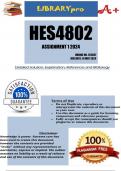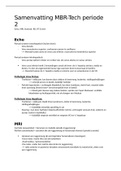HES4802
ASSIGNMENT 1 2024
UNIQUE NO. 152657
DUE DATE: 10 MAY 2024
, Assessment 1
Completion requirements
Opened: Monday, 1 April 2024, 8:00 AM
Due: Friday, 10 May 2024, 11:00 PM
152657
NB: You are encouraged to use your own words and to reference all the sources you
referred to in the correct way. Also remember to include your list of references at the
end of each assignment. Answers copied from sources are viewed as plagiarism and
marks will be deducted for such (This assignment will be subjected to Turnitin and any
form of plagiarism will punishable accordingly).
Your assignment should NOT BE MORE THAN 10 typed, 1.5 spaced pages inclusive of
the reference list.
QUESTION 1: Environmental monitoring (25 Marks)
Through environmental monitoring, it is known that most surface soils and water bodies
contain trace and ultra-trace levels of synthetic chemicals (e.g., dioxins, furans, diphenyl
ethers) and nuclear-fallout components (e.g., radioactive cesium etc). It is also known
that many surface waters, including dams, rivers and lakes contain trace concentrations
of pesticides resulting from agricultural runoff, persistent organic pollutants from
industrialisation and rainfall tainted with atmospheric pollutants.
In your own understanding , expand this statement by explaining what Environmental
Monitoring is and its role and significance. (25)
QUESTION 2 (25 Marks)
2.1 Comment on the four (4) sources of sample matrices and how they affect the
analysis. (8)
2.2 State Beer-Lambert’s law and explain how deviation from it can occur. (7)
2.3 Discuss common sample preservation methods or storage conditions that would
ensure sample stability during transportation and in the laboratory. (10)
QUESTION 3 (25 Marks)
South Africa faces many environmental challenges. A growing concern is the rising
level of air pollution, mainly from industrial emissions, domestic use of wood, coal and
paraffin, vehicle exhaust emissions, biomass burning, energy production and trans-
boundary air pollution. As a mitigation strategy, it was proposed that compliance to the
National Ambient Air Quality Standards be achieved by the year 2020, However, the
World Health Organization (WHO) has recently revised its Global Air Quality Guidelines
(AQGs). These guidelines recommend new air quality levels to protect the health of
populations by reducing levels of key air pollutants, some of which also contribute to
climate change.





